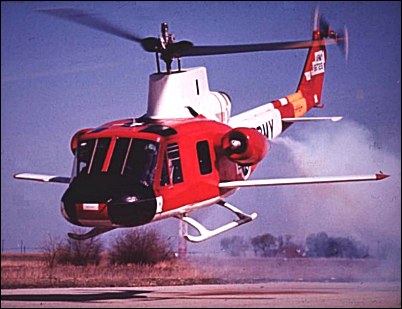
| Bell 533 1946 |  |
 |

| Bell 533 1946 |  |
 |
|
In 1959, the TRECOM (United States Army's Transportation Research Command) set up a programme in order to determine various rotor systems and methods of drag reduction for helicopters. As a result Bell modified the first YH-40-BF service test model (s/n 56-6723) as a research test-bed which was known at Bell as the Model 533. A lot of reworking was done on the airframe in order to reduce drag. These refinements included a cambered vertical tail surface to unload the tail rotor, streamlined fairing for the rotor head, flush air intakes located on each side of the new rotor fairing, redesigned cross-tubes for landing skids and new hinges for the doors. The well-known stabilising bar was removed and replaced by a variable-tilt rotor mast in order to maintain the fuselage in low-drag attitude. The 1.400shp Lycoming T53-L-13 turboshaft was retained. Tests in NASA's Ames wind tunnel showed that the aerodynamics of the airframe had been improved to such an extent that the equivalent flatplane area of the Huey had been reduced from 2.3m2 to 1m2. Still with its original US Army serial number, the Model 533 made its maiden flight on Friday 10 August, 1962, and flight tests were conducted at Fort Worth in late 1962. In March 1963, the Model 533 flew at 278km/h and 302km/h was attained in a shallow dive. As the months went by more and more modifications were introduced in this helicopter. Several rotor types were tested (two-blade UH-1B-like rotor and rigid three-blade rotors) and two 765-kg Continental J69-T-9 turbojets were installed on each side of the fuselage. Take-off weight of the aircraft was now 3880kg. On 17 January, 1964, the helicopter achieved a speed of 338km/h in level flight using only 780shp from the 1.100shp Lycoming T53-L-9A shaft-turbine, plus 568kg from the J69s. The next modification consisted of fitting two small sweptback fixed wings to convert the aircraft into a compound helicopter. On 11 May, 1964, it flew at 357km/h. The aircraft was then flown to San Antonio to have its J69-T-9s replaced by 765-kg J69-T-29s, and, on 15 October, 1964, the Model 533 was the first helicopter to break the 200 knots (370km/h) barrier by attaining 380km/h. On 6 April, 1965, the Model 533 flew at 402km/h in level flight and 409km/h in a shallow dive. It showed also its outstanding manoeuvrability in performing 2g turns and 60deg banks at speeds around 320km/h, and a Mach number of 0.985 was recorded by the advancing blades of the rotor. Early in 1968, a subsequent phase of the programme was the installation of two 1490-kg Pratt & Whitney JT12A-3 turbojets at the end of short stub wings. The first flight in this configuration was made in 1968, the machine gradually recording still higher speeds and, in May 1969, Bell announced that 508km/h had been attained. A.J.Pelletier "Bell Aircraft since 1935", 1992
Model 204 with experimental drag reduction mods including raised rotor mast fairings and flush air intakes, streamlined skids, recontoured fin with starboard side tailplane, twin externally mounted 765kg Continental J69-T9 turbojets and fixed wings for compound high speed flight tests. Prot. s/n 56-6723. FF 10 Aug. 1962. R.Simpson "Airlife's Helicopter and Rotorcraft", 1998
|